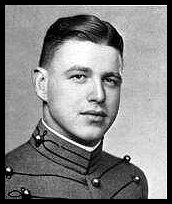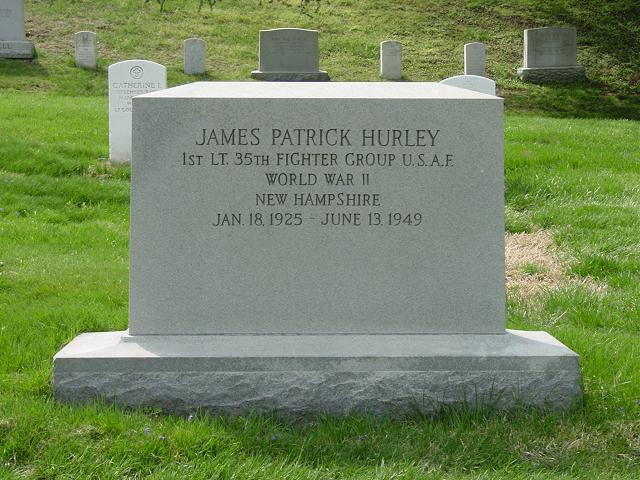Courtesy of his classmates
United States Military Academy, Class of 1946
James Patrick Hurley – NO. 15729 Class of 1946
Killed June 13, 1949 Near Misawa Air Base, Honshu, Japan,
in an aircraft accident, aged 24 years.

James Patrick Hurley was born on January 18th, 1925, at Arlington, Massachusetts, the son of Colonel and Mrs. Patrick J. Hurley. Like many Army Brats he spent his childhood with his family at several Army Posts. During the time he was in elementary school his father was stationed in Hawaii, and so Jim received most of his elementary schooling there. Hawaii made a lasting impression oil young Jim, and while he was there he learned a number of Hawaiian songs, which in later years he used to entertain his friends.
The next change of station brought the Hurleys to Fort Sam Houston in San Antonio, Texas. There Jim attended and graduated from Catholic Central High School. There, also, his inherent ability in military leadership was first brought to light. At graduation he was named the outstanding Cadet Captain in the school's R.O.T.C.
Early in his life Jim had set his sights on the Academy as a goal. During his high school days his ambition to attend the Academy was increased a hundredfold by his older brother Paul. Paul was at West Point then, taking flight training with his classmates. So Jim's ambition became twofold, to graduate from West Point, and to wear Silver Wings.
In 1943 Jim made two trips up the Hudson River, one in June to see Paul graduate, and the other in July. The second trip was a little more involved than the first, but the result was the same for the Hurley family, because three years later Jim graduated with his wings.
The first time I met Jim we didn't have much chance to get acquainted, for we were standing in a rigid brace, as is the custom for New Cadets, under a broiling July sun, in the middle of Central Area. That was my introduction to one of the finest men I have ever known.
From the very first day of Beast Barracks Jim became an integral part of his Company. He spent a good part of his time helping some of us make the difficult transition from College Joe to West Point Plebe. Paul had briefed him pretty thoroughly on Plebe life, and if it is possible for any phase of Beast Barracks to be made pleasant, Jim did that for his classmates. Throughout the three years at the Academy his room was the gathering Place for a song-fest, or a discussion on almost anything–poetry, flying, football, philosophy, and a thousand other subjects, or an after taps boodle fight. He was never without his guitar, and he could sing for hours without repeating a single song.
Jim loved sports, too, and he was a good athlete. His interest ranged from football to skiing, but I think his favorites were water sports–swimming, water polo, diving and surf planing. He had the kind of courage that scoffs at personal safety, not only in sports, but later on in his flying. No sport was too rough for him to try, nor any situation he encountered while flying, whether It be a gunnery mission or a zero-zero field condition.
Jim was overjoyed at the opportunity to take flight training while still at the Academy. Primary, Basic, and Advanced Train-ing were new and exciting experiences to Jim. Before long that part of flying which defies description, but which holds men to the sky, became Jim's driving force. Only those who have rolled a fighter on the deck, or who have flown through the empty sanctity of the sky, can know what this force is. Jim was one of those few privileged men.
Before long the hectic days at the Academy drifted into the past, and one day Jim walked up onto a platform, saluted, shook hands with General Spaatz, and walked away proudly with his own wings. At last he was a full-fledged pilot, and he had been accepted for training at Single Engine Fighter School. So Williams Field, Arizona, was his first station, and the slim, graceful F-51 his first, and later his last, fighter. Jim fell in love with the 51 even before his first flight. Why he was taken from this life is beyond the understanding of man, but since he was taken away, somehow it seems fitting that he went in a 51.
When we finished Fighter School we drew lots for assignments. Jim drew the 62nd Troop Carrier Group at Bergstrom Field, Austin, Texas. Though his heart was with fighters he contented himself with flying C-82's until he was sent overseas. Jim stayed at Bergstrom Field until June 1947. At that time the 62nd was transferred to McChord Field, Tacoma, Washington. He went with his group to Qashington and remained there until he received his overseas orders.
While Jim was stationed at McChord Field he was introduced to Jeanne Paulson of Tacoma. In the months that followed he began to realize that this quiet, beautiful girl was the One and Only. So he gave her a miniature, and they were married in the spring of 1948 at the McChord Field Chapel. Shortly after they returned from their honeymoon Jim was sent overseas to Japan.
When he arrived in Japan his dream of flying with a fighter group was at last realized, for he was assigned to the 40th Fighter Squadron of the 35th Fighter-Interceptor Group at Johnson Air Base, about 30 miles northwest of Tokyo. After the usual months of waiting, Jeanne finally joined him in Japan, and they soon had quarters at Johnson Air Base. Saturday night get -togethers at the Hurleys got to be almost a weekly event after that.
His time was filled with flying gunnery, rocket and dive bombing missions, and flying airborne alert with his squadron. But it was the kind of flying he loved, and with Jeanne overseas he was extremely happy.
Jim was engineering officer of his squadron, in addition to his flying duties. He was one of the best liked officers in the squadron, not only by his fellow officers but by his airmen as well. He spent countless hours with his men, working to keep the aircraft in commission.
One day he was chosen to lead his squadron in a practice raid on Misawa Air Base at the northern tip of Honshu. After the raid he led the squadron across Misawa in show formation. It was then that the Misawa pilot lost control of his aircraft and crashed into Jim.
The news of Jim's death came as a terrible shock to his wife, his parents, and his friends. It is hard to understand why he was taken from us while he was still so young, and had such a promising life before him. In an effort to help understand let me quote a part of “Pilot Bails Out”, by Don Blanding, which was Jim's favorite:
“Four things that make the perfect whole
Plane, hand and brain—and Pilot-Soul.
The hand is flesh-and flesh is frail;
The throbbing motored heart might fail;
The plane might falter down the sky
The anguished human brain might die;
But this we know-we dare not doubt,
With one triumphant deathless shout,
The valiant Pilot-Soul bails out.”
Jim is survived by his wife, Jeanne, his posthumous son, James, Jr., his parents, and his brother. He was laid to rest in Arlington National Cemetery.
-H. B. S. Jr.
Michael Robert Patterson was born in Arlington and is the son of a former officer of the US Army. So it was no wonder that sooner or later his interests drew him to American history and especially to American military history. Many of his articles can be found on renowned portals like the New York Times, Washingtonpost or Wikipedia.
Reviewed by: Michael Howard

